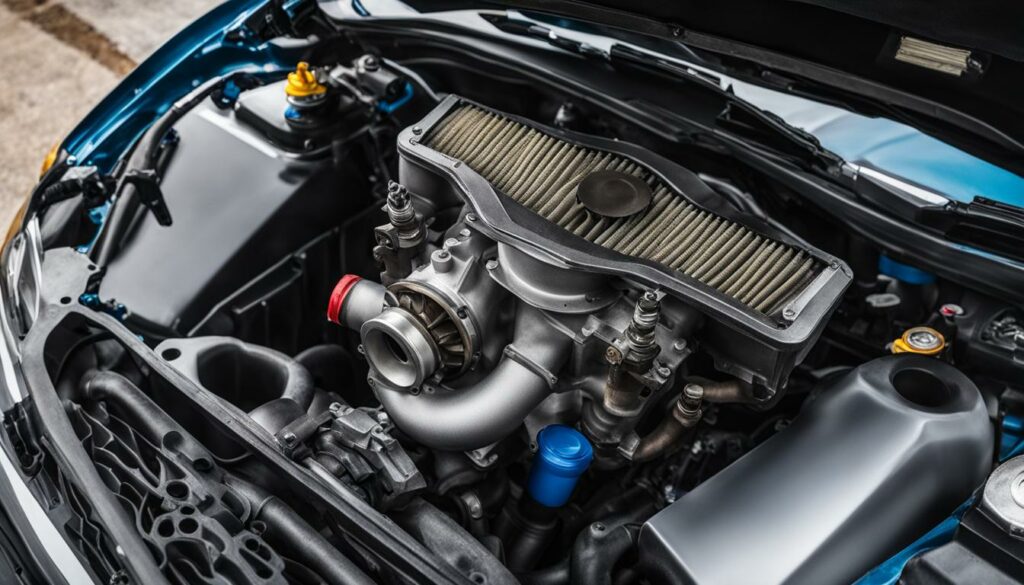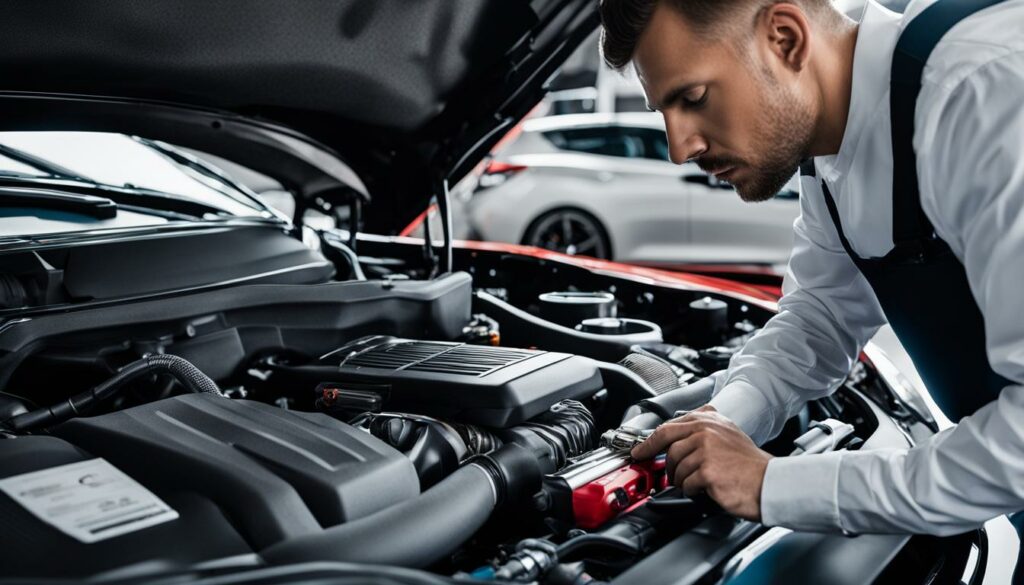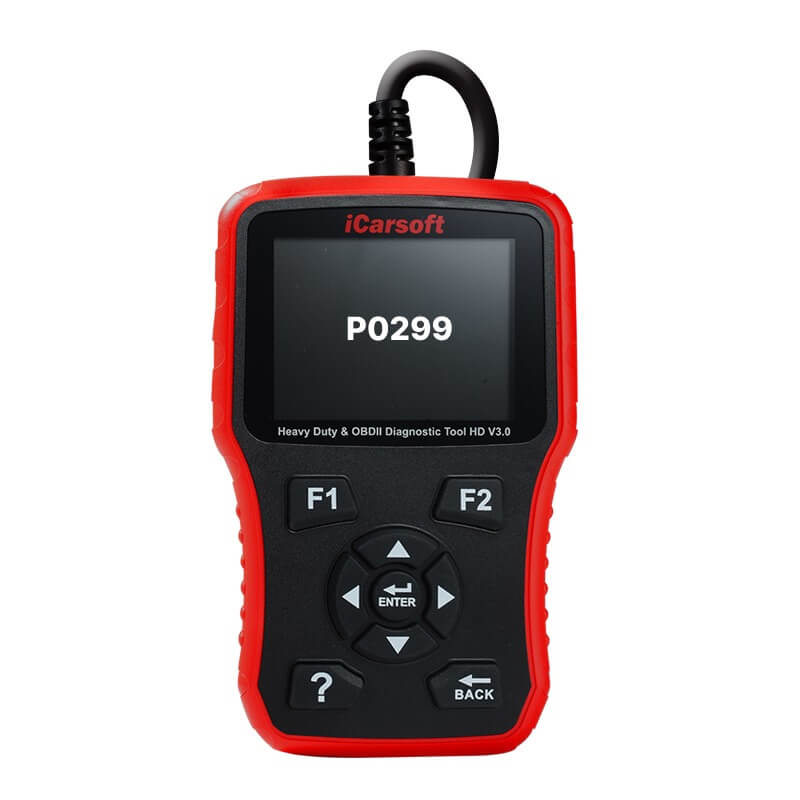P0299 – Turbocharger/Supercharger Underboost: Causes, Symptoms, Diagnosis, and Fixes
POSTED IN pcodes
If you own a vehicle equipped with a turbocharger or supercharger, you may have encountered the P0299 code, also known as “Turbocharger/Supercharger Underboost Condition.” This code is triggered when the engine’s turbocharger or supercharger is not producing enough boost pressure, leading to a drop in performance. Understanding the causes, symptoms, diagnosis, and fixes related to this code is essential to maintaining your vehicle’s optimal performance.
Key Takeaways:
- The P0299 code indicates an underboost condition in the turbocharger or supercharger system.
- Possible causes include intake air restriction, malfunctioning turbo/supercharger, faulty boost pressure sensor, and more.
- Common symptoms of P0299 include an illuminated check engine light, lack of acceleration/power, and abnormal engine sounds.
- Diagnosing the P0299 code requires the use of an OBD-II scan tool and inspection of the turbocharger/supercharger system.
- Fixing the P0299 code may involve repairing intake air leaks, replacing faulty components, or consulting a professional mechanic.
Understanding the P0299 Code
The P0299 code is associated with the Turbocharger/Supercharger Underboost Condition in your engine. Specifically, it indicates a problem with the turbocharger or supercharger, which are forced-induction devices that increase the intake of air into the engine.
In a normal engine, the downward movement of the pistons creates a vacuum that draws air and fuel into the engine. However, in a turbo/supercharged engine, a forced-induction device is used to deliver compressed air into the engine, resulting in greater power and performance.
The P0299 code is triggered when the boost pressure levels from the turbocharger or supercharger are below the specified limit set by the manufacturer. This underboost condition can lead to a decrease in engine power and efficiency.
Understanding the P0299 code is crucial for diagnosing and resolving the issue with your turbo/supercharged engine. By identifying the causes and symptoms of this code, you can take appropriate measures to restore optimal performance to your vehicle.
Buy tested tuning file for Adblue / EGR / DPF / Adblue off now!
Key Takeaways:
- The P0299 code indicates an underboost condition in the turbocharger or supercharger of your engine.
- A turbo/supercharged engine uses forced-induction to increase the intake of air into the engine.
- The P0299 code is triggered when boost pressure levels from the turbocharger or supercharger are below the manufacturer-specified limit.
- An underboost condition can lead to decreased engine power and efficiency.
Possible Causes of the P0299 Code
When the P0299 code is triggered, there are several potential causes that may contribute to this turbocharger/supercharger underboost condition. These causes include:
- Intake Air Restriction or Leaks: A restriction in the intake air flow or any leaks in the intake system, such as a clogged air filter or a damaged air intake hose, can disrupt the proper functioning of the turbocharger/supercharger system.
- Malfunctioning Turbo/Supercharger: The P0299 code can also be caused by a malfunctioning turbocharger or supercharger. This can occur due to worn-out internal components, a damaged turbine, or excessive play in the turbocharger/supercharger shaft.
- Faulty Boost Pressure Sensor: A faulty boost pressure sensor can provide inaccurate readings to the PCM, leading to improper boost pressure control and triggering the P0299 code.
- Wastegate Stuck Open: The wastegate is responsible for regulating the flow of exhaust gases to the turbocharger. If the wastegate gets stuck open, it can result in reduced boost pressure and trigger the P0299 code.
- Air Intake Leak: Any leaks in the air intake system, such as cracked intake pipes or loose clamps, can cause the turbocharger/supercharger to receive insufficient air, resulting in an underboost condition.
- Faulty BARO/MAP Sensor: The BARO (barometric pressure) or MAP (manifold absolute pressure) sensor measures the atmospheric pressure or intake pressure, respectively. A faulty sensor can provide incorrect readings to the PCM, leading to an underboost condition.
- Restricted Intercooler: The intercooler is responsible for cooling down the compressed air from the turbocharger/supercharger before it enters the engine. If the intercooler becomes restricted due to clogging or damage, it can reduce the effectiveness of the boost pressure and trigger the P0299 code.
- Circuit Issues: Electrical circuit problems, such as damaged wires, poor connections, or faulty solenoids, can disrupt the proper functioning of the turbocharger/supercharger system and lead to an underboost condition.
- PCM Issues: Problems with the PCM, such as outdated software or a malfunctioning control module, can interfere with the proper communication and operation of the turbocharger/supercharger system, resulting in the P0299 code.
Understanding these potential causes is crucial for accurately diagnosing and resolving the P0299 code. A comprehensive inspection and diagnostic process can help identify the specific issue causing the underboost condition and determine the appropriate repair steps.

Symptoms of the P0299 Code
When the P0299 code is triggered, several symptoms may be present. These include:
- Illuminated check engine light: The dashboard may display a warning light that indicates a problem with the turbocharger or supercharger system. This light serves as a signal to have the vehicle inspected for potential issues.
- Lack of acceleration or engine power: You may notice a significant decrease in acceleration or overall engine power. This can make it more challenging to reach desired speeds or pass other vehicles on the road.
- Abnormal engine sounds: Unusual noises, such as whining, rattling, or metallic sounds coming from the engine, can indicate a problem with the turbocharger or supercharger system. These sounds may occur during acceleration or while the engine is under load.
If you experience any of these symptoms, it is important to address them promptly to prevent further damage to the turbocharger or supercharger system. Ignoring these signs may lead to more significant issues and potentially costly repairs.
Diagnosing the P0299 Code
To diagnose the P0299 code, you will need to perform a series of diagnostic steps using the appropriate tools and techniques. Here is a breakdown of the diagnostic process:
- Start by connecting an OBD-II scan tool to the vehicle’s diagnostic port. This tool will allow you to retrieve any present codes, including the P0299 code.
- Review the freeze-frame data associated with the P0299 code. This data provides crucial information about the conditions under which the code was triggered, such as engine speed, coolant temperature, and throttle position. Analyzing the freeze-frame data can help narrow down the possible causes of the underboost condition.
- Perform a visual inspection of the turbocharger/supercharger system, as well as the EGR system, intake system, and other related components. Look for any visible signs of damage or leaks that may be contributing to the underboost condition.
- Use the OBD-II scan tool to check the boost pressure readings. Compare the actual boost pressure values to the manufacturer’s specifications. If the readings are consistently lower than the specified limit, it indicates a problem with the boost pressure system.
- Inspect the mechanical systems involved in the turbocharger/supercharger operation. This may include checking for any mechanical damage, worn-out components, or oil pressure issues. A comprehensive mechanical inspection can help identify any underlying problems affecting the boost pressure.
By following this diagnostic process, you can pinpoint the root cause of the P0299 code, whether it’s a sensor malfunction, a mechanical issue, or a problem with the intake system. Identifying the specific cause will enable you to take appropriate steps for repairing and resolving the underboost condition.

Fixing the P0299 Code
Fixing the P0299 code can be challenging and may require the expertise of a mechanic. Repair steps may vary depending on the specific vehicle. It’s recommended to consult a vehicle-specific repair manual or online repair database for detailed instructions.
Some common repairs for the P0299 code include:
- Fixing intake air leaks
- Replacing the air filter
- Addressing low engine oil pressure issues
- Repairing or replacing the boost pressure sensor
- Replacing the EGR system
- Replacing the turbocharger/supercharger
Consulting a professional mechanic is crucial to properly resolve the P0299 code and restore optimal engine performance. They have the skills, knowledge, and specialized tools, such as an OBD-II scanner, to accurately diagnose the issue and perform the necessary repairs.
Remember to follow the recommended repair steps provided by the manufacturer or trusted repair sources. A mechanic can guide you through the process, ensuring that each repair is done correctly and in the right order.
By addressing the underlying causes of the P0299 code and taking the appropriate repair actions, you can effectively fix the issue and optimize your vehicle’s turbocharger or supercharger system.
Example Repair Steps for P0299 Code
| Repair Step | Description |
|---|---|
| Step 1 | Inspect the intake system for any air leaks or restrictions. Repair or replace any damaged components. |
| Step 2 | Check the air filter for clogs or dirt buildup. Replace if necessary. |
| Step 3 | Verify the engine oil pressure and address any issues that may cause low oil pressure. |
| Step 4 | Test and replace the boost pressure sensor if it’s malfunctioning. |
| Step 5 | Inspect the EGR system for faults. Repair or replace any faulty components. |
| Step 6 | If all other repairs fail to resolve the issue, consider replacing the turbocharger or supercharger. |
Conclusion
The P0299 code is a significant indicator of a turbocharger/supercharger underboost condition, which can greatly impact your vehicle’s performance. Understanding the causes, symptoms, diagnosis, and repair steps associated with this code is essential for proper maintenance. Regular servicing and maintenance of your turbocharger/supercharger system can help prevent and address common issues that may lead to the P0299 code.
If you experience the P0299 code, it is crucial to seek professional diagnosis and repairs from a qualified mechanic. They have the expertise and tools to accurately identify the underlying issue and provide the necessary repairs. Ignoring or neglecting the P0299 code can result in further damage to your turbocharger/supercharger system and compromise your engine’s performance.
Remember, proper diagnosis and repairs are key to resolving the P0299 code. Regular servicing, including routine inspections and maintenance of your turbocharger/supercharger system, can help prevent the occurrence of this code. By addressing issues promptly and maintaining your vehicle’s turbocharger/supercharger system, you can ensure optimal engine performance and extend the longevity of your vehicle.
FAQ
What is the meaning of the P0299 code?
The P0299 code, also known as “Turbocharger/Supercharger Underboost Condition,” is triggered when the PCM detects that the turbocharger or supercharger is producing boost pressure levels in the intake manifold below the manufacturer-specified limit.
What are the common causes of the P0299 code?
Some common causes of the P0299 code include intake air restriction, a malfunctioning turbo/supercharger, a faulty boost pressure sensor, a wastegate stuck open, air intake leaks, faulty BARO/MAP sensor, a restricted intercooler, circuit issues, or problems with the PCM.
What are the symptoms of the P0299 code?
Symptoms of the P0299 code may include an illuminated check engine light, lack of acceleration or engine power, and abnormal sounds coming from the engine.
How is the P0299 code diagnosed?
To diagnose the P0299 code, a mechanic will typically use an OBD-II scan tool to check for any present codes and review the freeze-frame data. They will then perform a visual inspection of the turbocharger/supercharger system, EGR system, intake system, and other associated systems. The mechanic may also use the scan tool to check boost pressure readings and inspect mechanical systems like the turbocharger/supercharger and oil pressure.
How can the P0299 code be fixed?
Fixing the P0299 code may require the expertise of a mechanic. Repair steps may vary depending on the specific vehicle, but some common repairs include fixing intake air leaks, replacing the air filter, addressing low engine oil pressure issues, repairing/replacing the boost pressure sensor, replacing the EGR system, or replacing the turbocharger/supercharger.
What should I do if I experience the P0299 code?
When experiencing the P0299 code, it’s important to seek professional diagnosis and repairs to ensure the problem is resolved accurately and efficiently. Regular turbocharger/supercharger maintenance, including proper servicing, can prevent and address common issues that lead to the P0299 code.


